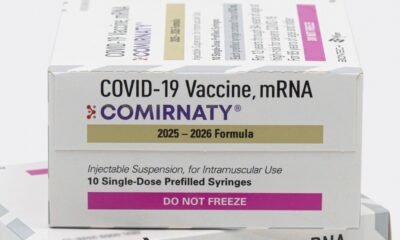Calvin Carter has built a career on moving before markets tip. His latest bet on AI inside electronic health records—the workflow backbone of healthcare—comes just as industry giants raise the stakes.
In late April, the serial entrepreneur and investor acquired Utah-based ScribeMatic, an AI healthcare documentation startup. He relocated the company to Dallas, stepped in as CEO, and began building out a team and expanding the business model, confident that demand for its core technology was about to take off.
That conviction sharpened Tuesday when the company launched Matic Inside, an embedded AI documentation platform designed for independent electronic health record systems. The goal is to give mid-sized and specialty EHRs the same capabilities as industry giants without the cost, risk, or years of in-house development.
Whether prescient or lucky, the timing was striking.
Just a week earlier, Epic Systems—by far the dominant player in EHRs—unveiled what was called an “AI overhaul” at its annual user conference, rolling out hundreds of artificial intelligence capabilities powered by Microsoft.
With more than 40% of the hospital records market, Epic’s move jolted the industry overnight. The EHR giant said its embedded AI scribe will reach nearly half the U.S. hospital market by 2026.
Carter’s reaction was one word: “Hallelujah.” For him, the announcement was market validation.
It also gave him the “existential force” he needed. “AI isn’t a future problem for the EHRs anymore,” Carter said. “It’s a right now crisis. The rules have changed.”
Epic may have brought the urgency to the fore, but its impact ripples across the market. The timeline leaves mid-sized and specialty vendors little time to wait. For the hundreds of EHRs competing against a handful of industry giants, it’s something of a David-and-Goliath moment—and Carter casts himself as their ally.
“Embedded AI has now become table stakes,” he said. “We have something you can demo today. There’s no execution risk.”
To build or not to build
For the roughly 500-plus smaller EHR vendors, Carter sees an impossible choice. Spend millions and years building AI capabilities that might never ship, or risk losing customers to competitors who have it.
“AI is harder than you think. The vast majority of AI projects in healthcare do not ship,” the CEO told Dallas Innovates.
The odds aren’t in their favor. Research cited by the company shows that 80% of healthcare AI pilots fail to scale, and less than half of prototypes make it into production. Meanwhile, the stakes are getting bigger: The global electronic health records sector is projected to reach $43.62 billion by 2032, up from $27.74 billion in 2021, according to the CDC.
For EHRs that need embedded AI “like yesterday,” Carter said, building in-house is not just expensive—it’s a gamble many will lose.
In an open letter to the industry earlier this month, Carter warned the industry: “Embedded AI scribing is no longer a differentiator … Clinicians are seeing it, competitors are selling it, and procurement teams are adding it to RFP checklists. The EHRs that move now will lock in loyalty and growth. Those that hesitate will fight to win back customers on someone else’s terms.”
And even for those willing to try, the hurdles are steep. Handling protected health information inside clinical workflows requires what Carter calls a “compliance gauntlet”—HIPAA, SOC 2, HITRUST, data residency rules, model drift surveillance, audit logging, and more.
That’s where he believes Matic Inside can close the gap. “We can get you there in weeks and months and for hundreds of thousands, versus quarters and years and millions,” Carter said.
Timing is everything
This isn’t the first time Carter has caught a market at its inflection point.
In 1999, he took Luminant Worldwide public during the dot-com boom. Less than a decade later, in 2008, he launched Bottle Rocket the day after Steve Jobs opened the iPhone to third-party developers. The digital experience company grew 94% annually, earned four Apple Hall of Fame awards—no other company has more than one—and was acquired by WPP in 2013. Carter stayed on as CEO until 2022, guiding it through mobile’s rise as a platform.
After stepping away, he ran his family office and pursued ventures in algorithmic trading, astrophotography, and scientific research. In 2024, he co-founded Dallas Opportunity Partners with Derek Wilson and Bob Bennett, launching an operator-led investment platform designed for North Texas deals.
Even while building DOP, Carter was scanning for what was next.
That search led him to ScribeMatic founder Alex Sheppert, an AI engineer who had taken an unusual detour: enrolling in medical school to learn healthcare from the inside.
The engineer who became a doctor
During his clinical rotations, Alex Sheppert found himself “walking around with a pad of paper” taking notes for doctors. “It’s so inefficient. There’s so many other things I should be doing with my time,” Carter recalled him saying. So Sheppert built his own AI scribe.
Doctors and faculty who saw it told him it was better than enterprise tools already in use. And Carter recognized the potential of both the technology and the founder.
He’s the best of us, the CEO says. “He doesn’t have a God complex. He doesn’t have a big ego,” Carter says of Sheppert, who is now both a physician and the company’s founder and CTO. “He’s a super smart, super passionate person.”
Dr. Sheppert, a medical doctor who also holds a Ph.D., co-founded Scribematic on the idea of a platform “built by a physician for physicians”—a theme Carter says still guides the company’s development.
Today, Sheppert continues his residency while serving as CTO and leading the engineering team.
His insights into the clinical workflow are key to the company’s core technology. “Every health system is different. Every type of medicine is different,” Carter said. “Every doctor has a different, unique desire of how their notes are put together.”
From scribe to embedded AI infrastructure
ScribeMatic’s origins trace back to 2021, when Sheppert co-founded the Utah-based company with operating executive Steven Pearson. The pair launched their AI-powered scribing platform publicly in 2023, giving individual providers a HIPAA-compliant way to generate clinical notes from any phone or computer.
The clinician-facing “scribe that charts”, now used by 200 doctors and integrated with EHRs such as Athena, AdvancedMD, and Chart Path, was the foundation. This week’s launch of Matic Inside takes the company’s core technology further, embedding it directly into EHR platforms.
What Sheppert built isn’t just another transcription tool, Carter points out. The AI technology is designed to function as a native feature inside an EHR’s workflow.
With the launch of Matic Inside, the platform delivers its technology as embedded AI infrastructure.
Carter says Sheppert has “figured out all the seats at the table”—transcription, summarization, filtering non-medical conversation—and built a system that assigns the best AI to each.
The system uses a combination of AIs that specialize in certain things. “It’s actually better … It’s like the hunter, the farmer, the basket weaver,” Carter explains.
Periodically, the system runs simulations, testing which language model performs best for each task, including transcription, summarization, and coding.
Behind the scenes, he says, the system runs ongoing simulations to determine which language model performs best for each task, from transcription to coding. It can also handle multilingual conversations, including “complex scenarios” such as a doctor speaking English, a patient speaking Spanish, and a teenage child translating.
Matic Inside adapts to user preferences. Clinicians can train it with past notes or through conversation. It embeds insurance justifications directly into notes to ensure, as Carter put it, “the doctor gets paid fairly.”
For EHR vendors, the technology ships as what Carter calls “headless services”—microservices and APIs that embed directly into EHR code, with no visible third-party brand and no external data access.
Scribematic also emphasizes its developer-friendly approach, offering APIs and direct engineer-to-engineer support to help EHR platforms integrate the technology into their own systems.
The company positions Matic Inside as the “first fully embedded option for mid-sized EHRs.” Its an infrastructure play that helps mid-sized and specialty EHRs compete on equal footing with the giants, Carter says.
The market math
Carter says beyond the handful of EHR giants, there are hundreds of specialty and regional players serving specific niches—”hospice, home health care, urgent care, emergency rooms.”
And each now faces Epic’s new AI-powered standard, he says. Other large competitors, including Oracle Health, are racing to keep pace with their own AI rollouts in what Carter calls a “win or lose” moment for EHRs. Renewal conversations, he points out, are shifting from “why do we need AI?” to “why doesn’t your platform already have this?”
The landscape is fragmented. “When you say Epic has 42%, there’s still a lot left,” Carter said. But fragmentation doesn’t mean safety. “Ground-up-built brand new EHRs with AI working in every corner” are already emerging to challenge incumbents.
For existing EHRs without AI, “it’s just like fuel on that bad fire,” Carter added. “So we are there to help.”
From bolt on to built in
Early on, Carter recognized a fundamental problem with how the EHR market has approached AI scribing.
“They invited the wolf into the hen house,” he told Dallas Innovates. Third-party AI scribes bolt onto EHR systems, taking revenue away from the platform and “disintermediating it” from its customer.
His analogy is clear. “It’d be like going to Chick-fil-A and saying, ‘Can I please have a lemonade?’ And they say, ‘We don’t do lemonade. But there’s a lemonade stand right there in the corner next to the playground, and they have free rent here, and you can pay them $4.’”
Two months ago, Carter pivoted. Instead of being another lemonade stand, Scribematic would help Chick-fil-A make its own lemonade.
He likens the approach to Intel’s famous model. With Matic Inside, he says, EHRs keep their customers, data, and revenue.
That case is beginning to resonate. One prospective client who initially wanted to bolt on changed their mind after hearing Carter’s terms.
“I want you to be your customer,” he recalled telling them. “I don’t want to even know how much you charge for what I give you. I don’t want your customers’ data. They don’t even need to know I exist.”
Leadership’s response was immediate: “I loved every word you said… because our only other choice is to have our engineers go off their current projects and spend a lot of time catching up on AI.”
Building in Dallas
Today, the company employs 15 people. Carter and CMO Shannon Prager are based in Dallas, alongside the head of product and president. Engineering talent is distributed—Sheppert continues his residency in Washington while managing a team across Canada, Los Angeles, and Utah.
Dallas entrepreneur Patrick Brandt, a longtime founder and investor, is among the company’s backers and serves as board advisor—and what Carter calls executive chair. “Titles, titles, titles,” he said, dismissing the formality. “It’s a startup.”
From its Dallas base, Carter says the goal is to move as fast as the market itself. As he knows from Bottle Rocket and the iPhone revolution, winners move quickly.
“There’s definitely an LLM arms race,” he said. “But now there’s an EHR arms race.”
Don’t miss what’s next. Subscribe to Dallas Innovates.
Track Dallas-Fort Worth’s business and innovation landscape with our curated news in your inbox Tuesday-Thursday.
R E A D N E X T
-
North Texas has plenty to see, hear, and watch. Here are our editors’ picks. Plus, you’ll find more selections to “save the date.”
-
Data scientist Anmolika Singh put Dallas on the global AI Tinkerers map. At the first meetup, more than 30 pros—founders to Fortune 500 technologists—showed up to trade ideas, projects, and solutions.
-
The BMW Dallas Marathon is gearing up for its 2025 race weekend, to be held in a long, winding course around White Rock Lake December 12–14. One way it’s doing that is by unveiling “a bold new logo” featuring a modern take on the Pegasus—Dallas’ celebrated icon—stretching its neck out toward victory. Along with a refreshed merchandise collection, the updated visual identity “reflects the organization’s evolution as a premier running event and its deep connection to the Dallas community,” organizers said.
-
UT Dallas researcher Dr. Walter Voit transformed Minecraft’s 170-million-player universe into an advanced virtual training ground—for students and for AI agents tested by DARPA. His team’s Polycraft World uses gameplay to turn classroom theory into real-world expertise, covering topics from synthetic organic chemistry to nuclear plants to semiconductor facilities. Their new startup company, Pedegree Studios, has licensed the core technologies from the university to create a scalable digital pipeline for education and workforce development.
-
Combining cutting-edge research and real-world applications, the UT Dallas professor transforms public health with innovations in detection technology, including “a check engine light” for the human body. In collaboration with EnLiSense, the company she cofounded, Dr. Prasad combines chemistry with software and hardware to bring the technology to life as market-ready devices.















































